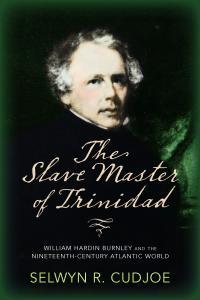The Slave Bible
By Dr Selwyn R. Cudjoe
April 18, 2022
In 1970 while I was a faculty member at Fordham University, New York, I taught a course on the development of Afro-American literature. One of the books I used was William Wells Brown, Clotel or the President's Daughter: A Narrative of Slave Life in the United States, published in England in 1853.
The novel told the story of Clotel, a daughter of Thomas Jefferson, the third president of the United States, who fathered three children by his slave, Sally Hemmings. Although the white power structure denied this incident for two centuries, in November 1998 the truth of this claim was authenticated by DNA evidence.
Apart from Clotel being sold into slavery, the novel was concerned with challenging the Biblical justification of slavery and that enslaved people should be obedient to their masters. One such exchange occurs when Pastor Hontz Snyder at The Poplar Farm took the enslaved through a recital of the following question-answer session:
Q: "What command has God given to servants concerning obedience to their masters?"
A: "Servants, obey in all things your masters according to the flesh, not with eyeservice as men-pleasers, but in singleness of heart, fearing God."
Q: "What does God mean by masters according to the flesh?"
A: "Masters of the world."
Q: "What are servants to count their masters worthy of?"
A: "All honour."
When the British missionaries came to the Caribbean, particularly in Jamaica, Barbados and Antigua, "to convert and educate" the enslaved, they brought with them their own version of the Bible tailored to their activities. Entitled Select Parts of the Holy Bible for the Use of the Negro Slaves in the British West-India Islands, this Bible was a "shockingly bowdlerised version of the New- and Old Testaments" that was printed in England in 1807—the same year the British slave trade ended in the West Indies.
Anthony Schmidt, associate curator of Bible and Religion, in the Museum of the Bible in Washington, DC, says that about 90 per cent of the Old Testament and 50 per cent of the New Testament is missing. He adds: "Put in another way, there are 1,189 chapters in a standard Protestant Bible. This Bible contains only 232."
Charlotte McKillop-Mash, project archivist, Bodleian Collections at Oxford University, notes: "This Bible has been carefully edited to remove any mention of people freeing themselves from bondage. In just one instance, it skips directly from Genesis 45:28 to Exodus 19, so it includes the Ten Commandments (Exodus 20) but 'disappears' the first eighteen books of Exodus, in which the Israelites escape slavery in Egypt."
This Bible was published by the Society for the Conversion and Religious Education of Negro Slaves—an organisation founded by Bishop Beilby Porteus, the son of a Virginian tobacco planter and a slave owner who was born and raised in England. Brigit Katz argues this Bible also sought "to teach enslaved Africans to read, with the ultimate goal of introducing them to Christianity". (Smithsonian Magazine, January 4, 2019.)
Paradoxically, Porteus, who later became the Anglican Bishop of London, "criticised the Church's position on slavery, preached and campaigned against the slave trade, and voted numerous times to ban it". He believed the abridged Bible would be more acceptable to the planters.
The verses that were placed in the Slave Bible reinforced the institution of slavery. One such edict, "Servants, be obedient to them that are your masters according to the flesh, with fear and trembling, in singleness of your heart, as unto Christ" (Ephesians 6:5) was replicated by Pastor Snyder in his question-and-answer session with the slaves that I reproduce above. Incidentally, Pastor Snyder was referred to as "a missionary" in the novel.
Sharon Brous, the founding rabbi of IKAR in Los Angeles, noted that the Slave Bible was designed to introduce enslaved people to Christianity and to preserve the system of slavery. "The slaveholders," she says, "were surely concerned that the enslaved people would see themselves in the Israelite struggle for liberation, that they would find strength in God's identification with the oppressed and be inspired by the triumph of faith over even one of the strongest regimes in the ancient world". (New York Times, April 14.)
Physical suffering, as Esau McCaulley observes, is "at the core of the Christian story". (New York Times, April 15.) Easter Sunday, according to the canonical texts of the Holy Bible, promises the triumph of our spiritual dimension over the death of the physical body. The Apocryphal gospels of the early Christians (such as the Gospel of Mary and the Gospel of Thomas) offer other events or sayings in Jesus' life.
As we celebrate Easter, the holiest day of the Christian calendar, we should remember that many of our ancestors did not have the comfort of Jesus' promise. Fr Martin Sirju, however, links Jesus "to the kingdom to truth" and suggests that Holy Week "begins with a politically subversive act—a peasant, apocalyptic preacher entering Jerusalem on a donkey". (Express, April 13.)
The Holy Bible also tells us that the meek shall inherit the earth, which suggests that everything presented in the Slave Bible was meant to prevent the meek, the oppressed, the overused Africans from realising the possibility of knowing the comfort of Jesus' message.
It is noteworthy also that the Slave Bible left out Jeremiah 22:13 from its abridged version of the Bible. The offending passage reads: "Woe unto him that buildeth his house by unrighteousness, and his chambers by wrong; that useth his neighbour's services without wages and giveth to him not for his work."
It is something our business people should ponder as they reflect upon the blessing that Easter brings to Christians throughout the world.
Prof Cudjoe's e-mail address is scudjoe@wellesley.edu. He can be reached @ProfessorCudjoe
Share your views here...

The Slave Master of Trinidad by Dr. Selwyn R. Cudjoe
|

